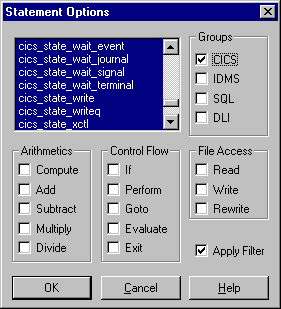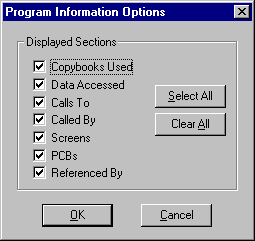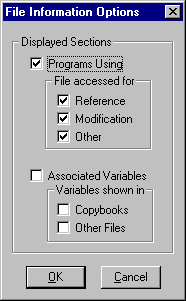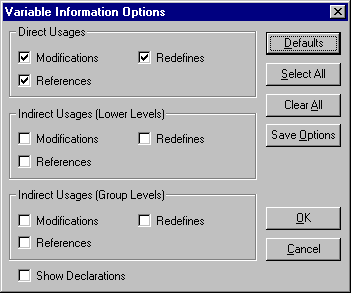

 | Tools | Utilities |  |
This chapter describes the Browsers that are available in Revolve. These Browsers are excellent vehicles for exploring your source code.
Browsers display detailed information and allow in depth analysis about analyzed source code. They are invoked from the Browsers menu. Also you can access a Browser from other tools and Browsers by right-clicking a displayed element and selecting Information.
All browsers make use of an information window. Information windows allow
dynamic expansion and contraction of displayed data that is customized to the
particular browser in use. With this type of control the user can directly
access specifics without being bogged down with details. If the browser has an
Options dialog, invoked with  ,
displayed information can be adjusted to show minimal or maximum detail. Default
options can be modified on the Utilities/Options/Browser menu.
,
displayed information can be adjusted to show minimal or maximum detail. Default
options can be modified on the Utilities/Options/Browser menu.
Browsers perform high level searches when a regular expression is entered into the Match edit box. Most browsers accept wildcards (*) in the Match edit box.
For example, to display information on all variables with the string "date" in their name, open the Variables Browser and type *date* in the Match edit box and press the Match button. A list of variables matching the selected criteria will be displayed.
The or bar, (|) may be used to enter multiple matching patterns for one query. For example, "*month*|*year*" would return all items which have either "month" or "year" in their name.
Note: The functionality described above differs in the Text Browser in that any characters entered into the Match edit field will be considered part of the text string. For example, if the wildcard character (*) or the Or bar (|) are used, Revolve will search source code files for text containing "*" or "|".
The Browsers Menu provides access to each of the browser. When a browser is opened with the Browsers menu, a match criteria must be entered into the Match edit box before any information is displayed in the information window.
All Revolve Browsers operate similarly. The following sequence is the basis for proper operation.
The Match edit box opens initially with a wildcard(*) character. This allows you the opportunity to view all elements pertaining to the Browserin your project. For example, if you press the Match button while the wildcard is displayed in the Screens edit field, then you will be presented with information on all the screens in your project.
Note: If the browser you are using contains an Options button
 you should consider adjusting your options before completion of step 2.
you should consider adjusting your options before completion of step 2.
The Text Browser allows you to find specific text strings in your project. Each line of text which is found is accompanied with comprehensive information that makes access to the source code and file that contains it quick and easy.
Note: Any characters entered into the Text field will be included in the text search. Asterisks(*) and Or bars (|) are considered actual text elements instead of wildcard characters.
When clicked, the Case Insensitive button
 indicates that the text search will retrieve matches regardless of case.
indicates that the text search will retrieve matches regardless of case.
The Text Browser can be used in two different modes: Program Mode and File Mode.
In Program Mode, activated with the Search all project files
button  , you enter:
, you enter:
The search is performed on loaded project files which match the specified type. Related files include COBOL programs, JCL, BMS, etc., as well as any copybooks or JCL procs.
For example, to find all occurrences of the string "date" in all files in the currently loaded project, use Program Mode, as opposed to File Mode, which searches files not necessarily defined or loaded in the project.
In File Mode, activated with the Specify search files button
 ,
you enter:
,
you enter:
Revolve searches through the file(s), finding any lines which contain text matching the given string. This is useful to search for text strings outside of the Revolve project.
Note: Revolve assumes that File Mode is being used to search for text strings outside of the loaded project, so Revolve features will not apply to File Mode matches (i.e. speed menu, annotations, tools, etc.).
The Statements Browser identifies statements in the source code,
including the names of the programs that contain the statements and the line
numbers of each usage. The Statement Options dialog is displayed when
you invoke this browser from the Browsers menu. It is also displayed
with  Options
.
Options
.

The Statement Options dialog contains a listbox of all statement types which can be found. Select individual statements in the list, or select by: Groups, Arithmetics, Control Flow, and/or File Access. If specifications are not made, an information list will not be collected.
Unlike other browsers, programs, not statements, are the top level items. When you enter an item in the Match edit field it must be the particular program where a statement is located as opposed to the statement itself.
Statement Options must be used to set the criteria for the statement search.
The Programs Browser displays detailed information about programs/load modules. You can view which copybooks and data files are used by a program/load module, as well as the usages of the program/load module in other components. Program accessed screens and line numbers are also given.
You can screen the information that is displayed in the information window
by making specifications in the Program Information Options dialog box.
Select the Options button
 to display the dialog.
to display the dialog.

By default, the Programs Browser will display all the information listed in the Options dialog. Any of these categories can be turned on or off in the options box.
The Copybooks and Includes Browser displays information about
copybooks and includes in the source code. Each line displays the number of
usages and the physical path of the import. Once expanded, you can see the
components that use the import and the individual usages. By selecting displayed
items and clicking the Expand One Level button
 ,
you have a complete import cross-reference report for your entire system.
,
you have a complete import cross-reference report for your entire system.
The Procs and Control Cards Browser displays information about JCL procs and control cards. You have access to information about the physical file containing the proc, the number of usages of the proc and control cards by JCL components, and the names of the JCL components that use the procs and control cards.
The Data File Browser displays information about files used by
programs in the project. This browser lets you quickly see where a file is
accessed across an entire project. It displays the on-line programs, batch
programs, and JCL's which access the file. And if you need more detail the
browser will go directly to the program statements or JCL DD's where the files
are accessed. The Data Files Browser will also display what buffers and
copybooks are being used with each file, by using the Associated Variables
option in the File Information Options dialog, accessible via the
Options button
 .
.
The Data File Browser provides you with the ability to adjust the
information that is displayed in the information window. The File
Information Options dialog is invoked when the Options button
 is selected.
is selected.

Consistent with other Revolve windows, the options dialog gives you complete control over the displayed information.
The Variables Browser displays comprehensive information about the variables and conditionals used in your application. You can access a variable's line number, as well as the file names that modify, reference, or redefine it. Also, the usage of a variable across a project can be viewed from this browser.
Note: The Variables Browser can display up to 32,767 variables. If the number of variables in your project exceeds 32,000 and you use the asterisk (*) wildcard character to identify all variables, then Revolve will display an error message. This can be avoided by using pattern matching to identify variables in large capacity projects.
In Program Mode
 (default mode) all data usage is categorized by logical programs. A logical
program includes not only the contents of the COBOL file but also the contents
of all copybooks and includes which are found during the load. Therefore, if a
variable is declared or used in a copybook that is used by many COBOL programs,
then each program using that copybook will be listed in the information window
when the variable is expanded.
(default mode) all data usage is categorized by logical programs. A logical
program includes not only the contents of the COBOL file but also the contents
of all copybooks and includes which are found during the load. Therefore, if a
variable is declared or used in a copybook that is used by many COBOL programs,
then each program using that copybook will be listed in the information window
when the variable is expanded.
File Mode
 groups the usages by physical file. Copybooks which include usages or
definitions of a variable are only listed once in the information window. COBOL
programs must have a usage or definition outside of copybook or include for the
program to appear in the information window when a variable is expanded.
groups the usages by physical file. Copybooks which include usages or
definitions of a variable are only listed once in the information window. COBOL
programs must have a usage or definition outside of copybook or include for the
program to appear in the information window when a variable is expanded.
The Variables browser can be adjusted to screen and filter the information that is displayed. Consistent with other Revolve windows, the Options button can be pressed to invoke an options dialog with which the user can have complete control over the information that is displayed in the Variables information window.

All direct redefines, direct references, and direct modifications of the specified variable will be set by default in the Variable Information Options dialog. In addition to the default criteria you can modify the specifications to include information about other variables that are related to the specified variable. You have the following options:
The Paragraphs and Sections Browser displays information about labels in the source code. With the Paragraphs and Sections Browser you have access to the name of the file(s) containing the paragraph or section, the line number of the label, the calls to the label, and the calls made within the label.
The Literals Browser displays information about literals used in the source code. With the Literals Browser you can access the number of occurrences of the specified literal, the name of the files containing the literal, line numbers of the literal within the file, and the entire line of text containing the literal.
The JCL Jobs Browser displays information about JCL jobs. With this browser, you can quickly see which programs are called by the JCL job and which data files are accessed. This browser will also display schedules and subprojects that contain jobs. If the Unisys Extension™ is installed this browser will display ECL called programs and data files.
The Screens Browser displays information about the screens used by the programs in your project. With the Screens Information Browser, you can access information about the file which contains a screen definition, programs that use the screen, the line number, and type of each screen access.
The Fields Browser displays information about fields used by screens or programs in the project. You can access information about the screens which contain the fields, the programs using the fields, the line number, and field type.
The CICS Browser displays information about CICS datasets, programs,
and transactions used in the source code. By accessing the
CICS Browser you can view programs that access the entities and the
actual calls that perform the access (CICS reads/writes, xctl's, etc.). By
selecting all items in the information window and clicking the Expand One
Level button
 you can quickly get a cross-reference report showing which programs access
different datasets, programs, and transactions. The aliased name is given in
parentheses.
you can quickly get a cross-reference report showing which programs access
different datasets, programs, and transactions. The aliased name is given in
parentheses.
The IMS Browser displays information about IMS entities used in the source code. By using this browser, you can cross-reference IMS Datasets, IMS PSB's, and IMS Transactions.
With the SQL Browser you have access to comprehensive information about database tables and columns that are used in the source code. The information window will display the line numbers and types of each reference, as well as the programs that reference the tables and columns.
Copyright © 1999 MERANT International Limited. All rights reserved.
This document and the proprietary marks and names
used herein are protected by international law.
 | Tools | Utilities |  |